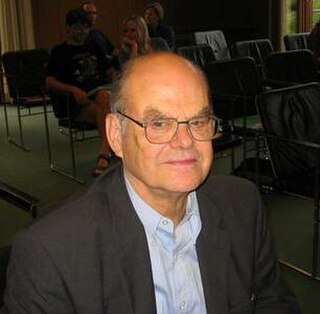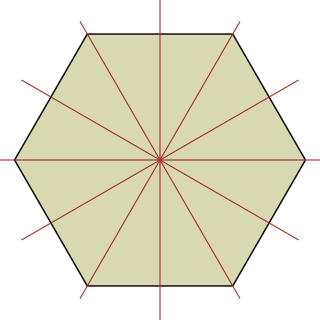Related Research Articles

In algebra, ring theory is the study of rings—algebraic structures in which addition and multiplication are defined and have similar properties to those operations defined for the integers. Ring theory studies the structure of rings, their representations, or, in different language, modules, special classes of rings, as well as an array of properties that proved to be of interest both within the theory itself and for its applications, such as homological properties and polynomial identities.
Invariant theory is a branch of abstract algebra dealing with actions of groups on algebraic varieties, such as vector spaces, from the point of view of their effect on functions. Classically, the theory dealt with the question of explicit description of polynomial functions that do not change, or are invariant, under the transformations from a given linear group. For example, if we consider the action of the special linear group SLn on the space of n by n matrices by left multiplication, then the determinant is an invariant of this action because the determinant of A X equals the determinant of X, when A is in SLn.
In mathematics, the Brauer group of a field K is an abelian group whose elements are Morita equivalence classes of central simple algebras over K, with addition given by the tensor product of algebras. It was defined by the algebraist Richard Brauer.

Richard Dagobert Brauer was a leading German and American mathematician. He worked mainly in abstract algebra, but made important contributions to number theory. He was the founder of modular representation theory.
In mathematics, more specifically in group theory, the character of a group representation is a function on the group that associates to each group element the trace of the corresponding matrix. The character carries the essential information about the representation in a more condensed form. Georg Frobenius initially developed representation theory of finite groups entirely based on the characters, and without any explicit matrix realization of representations themselves. This is possible because a complex representation of a finite group is determined by its character. The situation with representations over a field of positive characteristic, so-called "modular representations", is more delicate, but Richard Brauer developed a powerful theory of characters in this case as well. Many deep theorems on the structure of finite groups use characters of modular representations.

John Griggs Thompson is an American mathematician at the University of Florida noted for his work in the field of finite groups. He was awarded the Fields Medal in 1970, the Wolf Prize in 1992, and the Abel Prize in 2008.
Modular representation theory is a branch of mathematics, and is the part of representation theory that studies linear representations of finite groups over a field K of positive characteristic p, necessarily a prime number. As well as having applications to group theory, modular representations arise naturally in other branches of mathematics, such as algebraic geometry, coding theory, combinatorics and number theory.
In mathematics, the Feit–Thompson theorem, or odd order theorem, states that every finite group of odd order is solvable. It was proved by Walter Feit and John Griggs Thompson.

Walter Feit was an Austrian-born American mathematician who worked in finite group theory and representation theory. His contributions provided elementary infrastructure used in algebra, geometry, topology, number theory, and logic. His work helped the development and utilization of sectors like cryptography, chemistry, and physics.

Graham Higman FRS was a prominent English mathematician known for his contributions to group theory.
In mathematics, in the realm of group theory, a group is said to be a CA-group or centralizer abelian group if the centralizer of any nonidentity element is an abelian subgroup. Finite CA-groups are of historical importance as an early example of the type of classifications that would be used in the Feit–Thompson theorem and the classification of finite simple groups. Several important infinite groups are CA-groups, such as free groups, Tarski monsters, and some Burnside groups, and the locally finite CA-groups have been classified explicitly. CA-groups are also called commutative-transitive groups because commutativity is a transitive relation amongst the non-identity elements of a group if and only if the group is a CA-group.
Brauer's main theorems are three theorems in representation theory of finite groups linking the blocks of a finite group with those of its p-local subgroups, that is to say, the normalizers of its non-trivial p-subgroups.

Algebraic combinatorics is an area of mathematics that employs methods of abstract algebra, notably group theory and representation theory, in various combinatorial contexts and, conversely, applies combinatorial techniques to problems in algebra.
In mathematics, especially in the area of algebra known as representation theory, the representation ring of a group is a ring formed from all the finite-dimensional linear representations of the group. Elements of the representation ring are sometimes called virtual representations. For a given group, the ring will depend on the base field of the representations. The case of complex coefficients is the most developed, but the case of algebraically closed fields of characteristic p where the Sylow p-subgroups are cyclic is also theoretically approachable.

Representation theory is a branch of mathematics that studies abstract algebraic structures by representing their elements as linear transformations of vector spaces, and studies modules over these abstract algebraic structures. In essence, a representation makes an abstract algebraic object more concrete by describing its elements by matrices and their algebraic operations. The theory of matrices and linear operators is well-understood, so representations of more abstract objects in terms of familiar linear algebra objects helps glean properties and sometimes simplify calculations on more abstract theories.
In mathematics, especially in the area of abstract algebra known as module theory, a principal indecomposable module has many important relations to the study of a ring's modules, especially its simple modules, projective modules, and indecomposable modules.

Jonathan Lazare Alperin is an American mathematician specializing in the area of algebra known as group theory. He is notable for his work in group theory which has been cited over 500 times according to the Mathematical Reviews. The Alperin–Brauer–Gorenstein theorem is named after him.
In mathematics, the Artin conductor is a number or ideal associated to a character of a Galois group of a local or global field, introduced by Emil Artin as an expression appearing in the functional equation of an Artin L-function.
Everett Clarence Dade is a mathematician at University of Illinois at Urbana–Champaign working on finite groups and representation theory, who introduced the Dade isometry and Dade's conjecture. While an undergraduate at Harvard University, he became a Putnam Fellow twice, in 1955 and 1957.
In mathematics, the Hasse invariant of an algebra is an invariant attached to a Brauer class of algebras over a field. The concept is named after Helmut Hasse. The invariant plays a role in local class field theory.
References
- Feit, Walter (1984), "Possible Brauer trees", Illinois Journal of Mathematics, 28 (1): 43–56, doi: 10.1215/ijm/1256046152 , ISSN 0019-2082, MR 0730710
- Hiss, G.; Lux, K. (1989), Brauer trees of sporadic groups , Oxford Science Publications, The Clarendon Press Oxford University Press, ISBN 978-0-19-853381-8, MR 1033265
- Alperin, J.L. (1986), Local representation theory. Modular representations as an introduction to local representation theory of finite groups, Cambridge Studies in Advanced Mathematics, vol. 11, Cambridge etc.: Cambridge University Press, ISBN 0-521-44926-X, Zbl 0593.20003